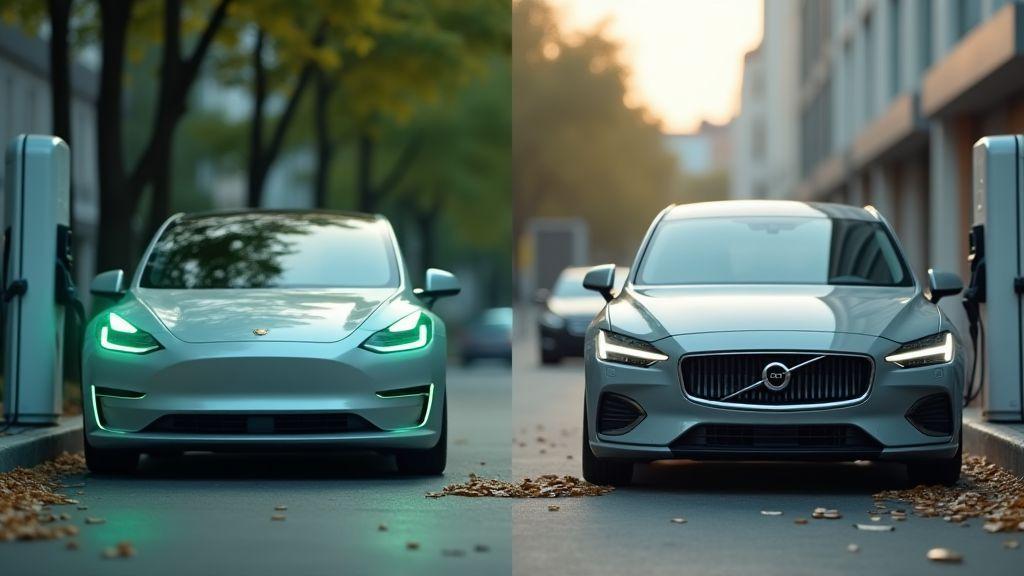Electric Cars vs Gas Cars: Which Is Cheaper in the Long Run?
This guide shows how to compare upfront price and incentives that lower your cost, and how federal and state rebates change your net purchase price. You’ll get clear checks for fuel and charging cost per mile, see how driving habits and home charging affect the math, and learn what maintenance, battery lifespan, and depreciation mean for total cost of ownership. Use this to run a simple break-even check and find when an EV saves you money.
Key takeaway
- EVs usually cost less for energy (per mile) than gas cars.
- EVs need less routine maintenance, lowering repair bills.
- Many EVs cost more up front, but federal/state incentives and dealer discounts can narrow or erase that gap.
- Battery life and resale value significantly affect long-run costs.
- Your charging access and driving patterns determine the size of the savings.

Upfront price and incentives that affect what you pay
Sticker price for an electric car can be higher because of the battery and newer tech. Don’t stop at sticker shock—subtract tax credits, state rebates, dealer discounts, and any lower registration or fuel taxes. Those savings can make an EV worth a close look.
Incentives come in different forms and timing. Federal tax credits lower your federal tax bill after you buy; some dealers or states offer point-of-sale rebates that reduce the price immediately. Build your numbers around the incentives you can actually claim, not the face value in brochures. Fees (sales tax, registration, dealer fees, EV surcharges) also change your out‑the‑door cost—some states waive these for EVs, which can shift the math quickly. Check your state energy office or DMV or Find state and federal EV incentives to see what applies in your area.
How federal and state incentives lower your EV purchase price
Federal EV credits reduce your tax bill up to set amounts for qualifying vehicles; some dealers offer pass-throughs at sale. How the federal EV tax credit works and who qualifies are detailed by the IRS. State incentives vary: flat rebates, tax credits, reduced registration, HOV access, or point-of-sale discounts. Check your state energy office or DMV because programs change.
Using rebates and tax credits in an Electric Cars vs Gas Cars: Which Is Cheaper in the Long Run? comparison
Stack rebates and credits and your net EV purchase price can approach or undercut a gas car. Use realistic numbers: MSRP, dealer discounts, federal credit (if eligible), and state rebates. Note some credits have rules about battery sourcing or income limits.
Example (replace with your quotes):
| Item | Example EV | Example Gas Car |
|---|---|---|
| MSRP | $45,000 | $32,000 |
| Federal tax credit / rebate | -$6,000 | $0 |
| State rebate or incentive | -$2,000 | $0 |
| Dealer discounts / incentives | -$1,000 | -$500 |
| Net purchase price | $36,000 | $31,500 |
Estimate your net purchase cost after rebates and fees
Checklist:
- Start with MSRP or agreed sale price.
- Subtract point-of-sale rebates and dealer incentives.
- Subtract federal/state credits you actually qualify for (apply federal on your return).
- Add sales tax, registration, and dealer fees.
Do this for the EV and the gas car to see what you really pay today.
Fuel and charging cost per mile for your daily driving
You want a single number: cost per mile. Electric Cars vs Gas Cars: Which Is Cheaper in the Long Run? starts with this math.
Cost per mile = price you pay (per kWh or per gallon) ÷ how far the car goes on that energy (mi/kWh or mpg). Use your local electricity rate and the car’s efficiency. Many EVs achieve ~3–4 mi/kWh; many gas cars 20–35 mpg. Charging style changes the math—home overnight charging is usually cheaper than public fast charging. Cold weather, roof racks, heavy loads, and high speeds reduce efficiency. You can Calculate real-world fuel and charging costs and find official efficiency numbers to plug into your math.
Compare electricity kWh costs to gasoline per gallon for cost per mile
Cost per mile formulas:
- EV: price per kWh ÷ miles per kWh (add ~10% for charging losses if needed).
- Gas: price per gallon ÷ mpg.
Example:
| Scenario | Price | Efficiency | Cost per mile |
|---|---|---|---|
| EV — home charging | $0.13 / kWh | 3.5 mi/kWh | $0.13 ÷ 3.5 = $0.037 (3.7¢/mi) |
| Gas — local pump | $3.50 / gallon | 30 mpg | $3.50 ÷ 30 = $0.117 (11.7¢/mi) |
If electricity is $0.20/kWh at 3.5 mi/kWh = 5.7¢/mi. If gas is $4.00 and 25 mpg = 16¢/mi. Location and charging location matter.
How driving habits and home charging change cost per mile (electric vs gas)
- City stop-and-go often favors EVs (regenerative braking).
- Highway driving narrows the gap because EV efficiency falls at high speed.
- Home off-peak rates are often far cheaper than public fast chargers; public fees and charging losses can double cost per mile versus home charging.
Plug in your driving pattern and charging mix to get your real number.
Calculate your cost per mile for EVs and gas cars
- Find your electricity price per kWh (home off-peak or public rate).
- Get EV efficiency in mi/kWh (or kWh/100 mi).
- EV cost per mile = price per kWh ÷ miles per kWh ( ~10% for charging losses).
- Gas cost per mile = price per gallon ÷ real-world mpg.

Maintenance and repair costs: what you will pay over time
EVs typically cost less for routine upkeep: no oil changes, spark plugs, exhaust repairs, or many transmission services. Regenerative braking reduces brake wear. Fewer moving parts mean fewer failure points and fewer shop hours. Software updates can also fix issues remotely.
Batteries and high-voltage systems are expensive if they fail out of warranty, so factor warranty coverage and battery health into long-term planning. High annual miles increase the chance you’ll need a major battery expense over a long ownership period.
Why EV maintenance is often lower than gas maintenance costs
- Fewer moving parts, less to break.
- No oil changes.
- Regenerative braking reduces brake wear.
- Simpler cooling needs and remote updates reduce shop visits.
Common gasoline car repairs that raise total cost of ownership
Gas cars have recurring oil/filter changes and potential big-ticket repairs: transmission rebuilds, timing belt changes, fuel pump/injector failures, exhaust repairs. A single engine or transmission fault can erase years of maintenance savings.
Estimate annual maintenance savings when you switch to an EV
Compare annual totals (fuel maintenance for gas vs charging maintenance for EV). Typical savings range widely—many owners see roughly $800–$1,500 per year depending on miles and energy prices. Planning for battery warranty coverage and a replacement fund after ~8–12 years still usually leaves EVs favorable for many drivers.
Example annual comparison:
| Item | Typical — Gas car | Typical — EV | Approx. difference |
|---|---|---|---|
| Fuel / electricity | $1,200 | $300 | -$900 |
| Oil & filters | $150 | $0 | -$150 |
| Brakes & rotors | $200 | $120 | -$80 |
| Transmission service | $300 | $0 | -$300 |
| Other maintenance | $100 | $80 | -$20 |
| Estimated annual total | $1,950 | $500 | -$1,450 |
Battery lifespan and replacement cost impact on long-term cost of electric cars
The battery is the single biggest long-term cost variable for EVs. Research on EV battery degradation and lifespan helps quantify how packs age and what to expect for capacity loss and lifecycle costs. Batteries lose capacity over time, reducing range and resale value. Hot climates, frequent fast charging, and heavy use accelerate degradation. A full replacement is rare but can be costly.
Typical battery warranties and real-world degradation rates
Most manufacturers offer around an eight‑year or 100,000‑mile battery warranty; some offer longer coverage. Real-world reports often show ~10–20% capacity loss after 8–10 years, though many cars hold near 90% after a decade.
How battery replacement costs affect total cost of ownership (electric vs gasoline)
Battery swaps can range from several thousand to over $15,000 depending on pack size and labor. Compare that to major gas repairs (engine, transmission) which can also cost thousands. Many EV owners still come out ahead due to fuel and routine maintenance savings, especially high-mileage drivers or those with cheap electricity. But long-term owners of low-cost EVs without warranty support should model replacement scenarios.
Example 10-year/100k-mile ranges:
| Component | Electric car (approx.) | Gas car (approx.) |
|---|---|---|
| Energy / Fuel | $2,000–$6,000 (electricity) | $10,000–$20,000 (gasoline) |
| Routine maintenance | Low (brakes, tires) | Moderate (oil, filters) |
| Major component replacement | Battery: $5,000–$20,000 | Engine/transmission: $3,000–$10,000 |
| Typical unexpected large cost | Rare but high (battery) | Less rare, often moderate |
Factor battery replacement into your long-term cost model
- Estimate how long you’ll keep the car and annual miles.
- Add a battery replacement line with a price range and likely timing (e.g., year 8–12).
- Compare to fuel and maintenance for a gas car over the same period.
Run low/medium/high battery cost cases to see whether an EV stays cheaper for you.

Depreciation and resale value differences you should expect
EVs often drop faster in the first few years compared with many gas cars, driven by rapid battery/tech improvements and strong new-car incentives. After early years depreciation can level off and sometimes match or beat gas cars, depending on battery condition and brand reputation.
Market trends, policy changes, fuel prices, and charging infrastructure influence resale values quickly. If you’re asking “Electric Cars vs Gas Cars: Which Is Cheaper in the Long Run?”, resale value is a key, variable piece.
How EV depreciation trends compare to ICE vehicles in resale markets
ICE cars have predictable depreciation due to mature tech. EV resale is more volatile—battery health fears and fast tech turnover can depress prices, but rising used-EV demand and strong battery reports can support resale values.
Steps to preserve resale value and lower depreciation (EV vs ICE)
- Keep service records and receipts.
- Limit rapid charging and extreme temperature exposure for EVs.
- Avoid heavy modifications and excessive mileage.
- Store the car in a garage and protect interior/exterior.
- Get a professional battery health report before selling.
Project your vehicle’s resale value over time
Expect a steep early drop for many EVs, then a slower decline after year three. Use model-specific data, local demand, and battery warranty length for better forecasts.
Total cost of ownership and break-even analysis to answer which is cheaper
Total cost of ownership (TCO) includes purchase price, fuel/electricity, maintenance, insurance, and depreciation. Electric Cars vs Gas Cars: Which Is Cheaper in the Long Run? depends on how much you drive, local energy prices, incentives, and resale trends. Some drivers reach break-even in a few years; others take longer.
Crunching three big drivers usually decides it: purchase price gap, fuel savings, and depreciation. If an EV costs more up front, lower fuel and maintenance can pay that back. Use this simple method: list costs, compare annual totals, then divide extra upfront cost by yearly savings to find the break-even point.
Building a clear electric vs gas cars cost comparison
For a typical 12,000-mile year, electricity might cost about $0.05/mi while gasoline could be $0.13–$0.16/mi. That difference can save hundreds or more annually. Maintenance is typically lower for EVs.
Example annual cost buckets:
| Cost component | Example EV (annual) | Example Gas (annual) | Notes |
|---|---|---|---|
| Energy / Fuel | $600 | $1,680 | Based on 12,000 miles |
| Maintenance & Repairs | $400 | $900 | EVs lower |
| Depreciation | $4,000 | $3,500 | Varies by model |
| Insurance | $1,200 | $1,000 | Can be higher for EVs |
| Total annual cost | $6,200 | $7,080 | Example shows EV cheaper by $880/yr |
| Cost per mile | $0.52 | $0.59 | Divide total by miles driven |
Finding your break-even point and long-term savings
Calculate annual savings first. In the example above, savings = $880/yr. If the EV cost $6,000 more up front after incentives, break-even ≈ 6.8 years (extra upfront cost ÷ annual savings). Shorter commutes or low incentives push break-even out; heavy driving brings it in faster. Re-run calculations if electricity prices spike or battery replacement appears.
Run a simple TCO check
- Note purchase prices (EV and comparable gas), minus incentives.
- Estimate annual miles.
- Calculate energy/fuel cost per mile for both and multiply by annual miles.
- Add annual maintenance, insurance, and expected depreciation for each.
- Subtract annual totals to get yearly savings, then divide extra upfront EV cost by that savings to find years to break-even.
FAQ
Q: Electric Cars vs Gas Cars: Which Is Cheaper in the Long Run?
A: For many drivers, EVs are cheaper long-term because energy and routine maintenance costs are lower. Whether an EV is the cheaper choice for you depends on purchase price after incentives, your annual miles, local electricity vs gas prices, battery warranty/health, and resale expectations. Run a simple TCO and break-even calculation using your numbers.
Q: How soon do EVs typically break even?
A: Many buyers see break-even in 3–8 years depending on incentives, driving miles, and local energy prices.
Conclusion
In plain terms: an electric car often wins on energy and maintenance costs, while a gas car can look cheaper at the sticker. You may pay more up front for many EVs, but incentives, home charging, and lower cost per mile tend to tip the scales over time.
Do the math for your life: plug in MSRP after rebates, your real kWh or gallon price, and annual miles. Don’t forget battery age, warranty limits, and depreciation—those line items decide your true TCO and break-even year. Run low/medium/high scenarios so you aren’t surprised later. For additional guides and tools, see our Meridian Pioneer collection of guides and comparisons. Before sharing personal documents to claim rebates or incentives, review our privacy policy and terms of use. If you want personalized help or have questions about a specific model or incentive, reach out via our contact page.

